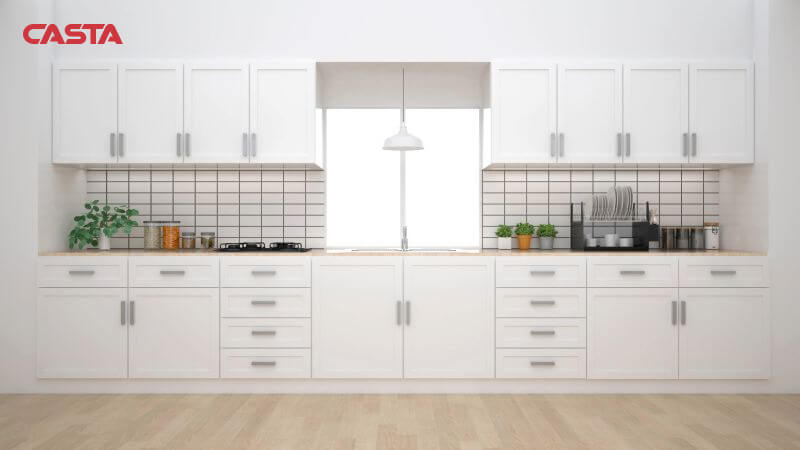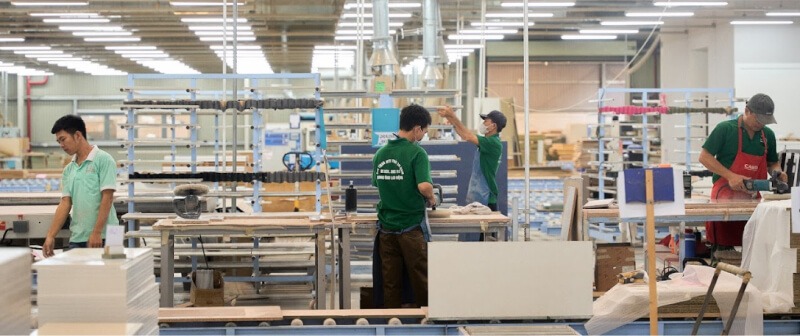For anyone seeking quality kitchen cabinets, China cabinet manufacturers have become a top destination due to their exceptional craftsmanship, affordability, and innovative designs. The leading manufacturers offer a diverse range of kitchen cabinetry solutions, from whole-house customization to specialized kitchen design. Below, we’ll explore 15 of the best China cabinet manufacturers, each with unique features and specializations that make them industry leaders.
Table of Contents
1. Top 15 China Cabinet Manufacturers
1. Boke Furniture
Boke Furniture, founded in 2012, stands out for its ergonomic and customizable furniture solutions for various spaces, including kitchens. Their commitment to sustainable practices and high-quality designs makes them a trusted name in the industry.
2. ZBOM Home Collection Co., Ltd.
Founded in 1998, ZBOM is known for its whole-house customization and specializes in kitchen cabinetry. As one of the most established China cabinet manufacturers, ZBOM’s products are widely sought for their extensive R&D efforts and innovative customization options.
3. Guangdong Piano Science Art Home Co., Ltd.
Since 2005, Piano has specialized in custom kitchen cabinets with an emphasis on high-end design. Known for its fashion-forward approach, Piano offers advanced production capabilities and a wide network of franchise locations.
4. Boloni Group
Boloni has been a recognized name since 1992, offering kitchen cabinets, wardrobes, and doors. Their reputation extends internationally, with showrooms worldwide showcasing their luxurious designs and premium home solutions.
5. Shangpin Home Furnishing Group
Also known as Homekoo, Shangpin integrates IT and cloud computing in its customization services. Founded in 2004, they provide an extensive range of home and kitchen solutions with a broad national reach.
6. SALM S.A.S Group
Operating since 1934 and primarily based in Europe, SALM S.A.S has expanded its influence into China, where it offers custom kitchen cabinets known for their quality and innovative design. They are a top choice for custom solutions.
7. Kefan Home Furnishing Co., Ltd.
Since its founding in 2006, Kefan has offered whole-house customization services, including kitchen cabinets. With intelligent manufacturing processes, they provide high-quality options for various home furnishings.
8. Oupai Home Furnishing Group Co., Ltd.
A pioneer in the industry, Oupai has been offering custom kitchen cabinets since 1994. Known for quality and innovation, Oupai remains a preferred choice among China cabinet manufacturers for its wide range of design solutions.
9. Golden Kitchen Cabinet Home Furnishing Technology Co., Ltd.
Founded in 1999, Golden Kitchen Cabinet focuses on high-end customization for kitchens and home furnishings. Their luxury designs and commitment to quality appeal to those seeking premium kitchen cabinetry.
10. Qingdao Haier Home Integration Co., Ltd.
Part of the renowned Haier Group, Qingdao Haier offers advanced kitchen cabinetry solutions that integrate smart technology. This blend of functionality and efficiency has positioned them as a leader among China cabinet manufacturers.
11. Qingdao Yufeng Hantang Wood Industry Co., Ltd.
Specializing in high-quality wood cabinetry, Yufeng Hantang has been a top choice since 2006. Their eco-friendly approach and attention to craftsmanship make them a great option for custom wood cabinets.
12. Borcci Home Solution
Founded in 2000, Borcci is known for integrated kitchen solutions that combine style and functionality. With a focus on innovation, Borcci remains a leader among China cabinet manufacturers.
13. Nanjing Olo Home Furnishing Co., Ltd.
Olo’s commitment to high-quality custom kitchen cabinetry has been strong since 2006. They are known for using premium materials and cutting-edge designs that cater to personalized home aesthetics.
14. Bai Desheng Home Furnishing Co., Ltd.
Since 2001, Bai Desheng has specialized in detailed craftsmanship for kitchen cabinets and wardrobes, providing unique styles and options for customers with varied preferences.
15. LESSO Group
LESSO is a leading name among China cabinet manufacturers, known for their custom kitchen cabinets and PVC materials. Founded in 2012, LESSO emphasizes sustainability and quality across its product lines.
These 15 companies showcase the versatility and quality standards of China cabinet manufacturers. With options ranging from high-end customization to eco-friendly solutions, they cater to a global market with diverse tastes and preferences.
Learn more: High end kitchen cabinet manufacturers
2. Vietnam vs China Cabinet Manufacturers: A Comparative Analysis
Choosing the right cabinet manufacturer, including those specializing in China cabinet manufacturers, can significantly impact your project's success, and selecting between Vietnam and China involves weighing their distinct advantages.
China is known for its advanced technology and large-scale production capabilities. With a focus on high-tech machinery and efficiency, China cabinet manufacturers are well-suited for bulk orders and standardized designs, thanks to their developed infrastructure and precision engineering.
Conversely, Vietnam offers a competitive edge with lower labor costs and a growing emphasis on modern technology. Vietnamese manufacturers excel in personalized service and customization, making them ideal for projects requiring unique designs. Their commitment to sustainable practices and eco-friendly materials aligns with the increasing global demand for environmentally responsible production.
This article provides a detailed comparative analysis of cabinet manufacturing in Vietnam and China, covering aspects such as manufacturing quality, technology, customization, shipping, and pricing.
Understanding these differences will help you make informed decisions tailored to your specific needs and preferences.
Let’s explore the key factors to consider when choosing between these two regions for your cabinetry solutions.
3. Manufacturing Quality, Technology, and Environmental Impact
3.1 Manufacturing Quality

| Criteria | Vietnam Cabinet Manufacturers | China Cabinet Manufacturers |
| Craftsmanship | Emphasizes artisanal craftsmanship and attention to detail. Vietnamese manufacturers integrate traditional woodworking techniques with modern production methods. | High-tech machinery and precision engineering focus on mass production, resulting in consistent quality across large volumes. |
| Advanced Machinery | Utilizes advanced European machinery, such as those from Homag and SCM, to ensure precision and high quality. | Extensive investment in robotics and automation for high productivity and uniformity. |
| Quality Control | Rigorous quality control processes, often involving detailed inspections and adherence to international standards. | Well-established quality control systems, with a focus on reducing defect rates through advanced technology. |
3.2 Environmental Impact
| Criteria | Vietnam Cabinet Manufacturers | China Cabinet Manufacturers |
| Environmental Regulations | Smaller-scale operations enable more sustainable practices. Many Vietnamese manufacturers hold FSC certifications. | Large-scale production results in significant environmental concerns, though recent improvements in regulations aim to address pollution. |
| Energy Efficiency | Growing focus on energy-efficient technologies and sustainable practices. | High energy consumption due to large-scale production, with ongoing efforts to improve efficiency. |
| Waste Management | Emphasis on waste reduction and recycling in smaller-scale operations. | More challenging waste management due to the volume of production, though advancements are being made. |
Craftsmanship:
Vietnamese manufacturers often emphasize artisanal skills, blending traditional techniques with modern methods to create unique, high-quality products. For instance, intricate hand-carvings and custom finishes are a hallmark of Vietnamese craftsmanship.
In contrast, China cabinet manufacturers focus on precision and consistency, leveraging advanced machinery to maintain high quality across large volumes.
Advanced Machinery:
European machinery used in Vietnam, such as Homag and SCM, provides a high level of precision, contributing to superior finish quality. China cabinet manufacturers' investment in robotics and automation allows for efficient mass production but may lack the artisanal touch seen in Vietnamese products.

Quality Control:
Both regions implement strict quality control, but their approaches differ. China kitchen cabinet manufacturers often employ rigorous quality assurance processes due to their scale, incorporating advanced technology to minimize defects. Vietnamese manufacturers, while also maintaining high standards, often rely on detailed manual inspections, reflecting their focus on craftsmanship.
Environmental Impact:
Vietnam's smaller-scale operations facilitate sustainable practices, such as FSC certification and waste reduction. China's large-scale production poses significant environmental challenges, though recent regulations and advancements aim to mitigate these issues.
Vietnam excels in artisanal craftsmanship and sustainable practices, whereas China offers advanced technology and extensive production capabilities but faces greater environmental challenges.
Learn more: Why Choose Vietnam for Cabinet Manufacturing?
4. Customization Options and Flexibility
| Criteria | Vietnam Cabinet Manufacturers | China Cabinet Manufacturers |
| Design Customization | Known for high levels of customization in design, materials, and finishes, reflecting artisanal expertise. | Offers standardized designs with options for semi-customization, suitable for large volumes. |
| Lead Times | Typically 4 to 6 weeks, allowing for quick adjustments and personalized service. | Generally 5 to 8 weeks, longer for complex or highly customized orders. |
| Production Scale | Smaller-scale operations facilitate detailed customization and personalized service. | Larger-scale operations with more automated processes, leading to less flexibility but higher efficiency. |
Design Customization:
Vietnamese manufacturers excel in bespoke design, offering a wide range of customization options. This flexibility is ideal for clients seeking unique, tailored products. China kitchen cabinet manufacturers, while providing some level of customization, often focus on standardized designs that cater to large volumes.

Lead Times:
Vietnam’s smaller production scale allows for quicker adjustments and shorter lead times, making it a suitable choice for projects with tight deadlines. In contrast, China’s larger operations may result in longer lead times, especially for highly customized orders.
Learn more: Lead Times & Supply Chain Resilience
Production Scale:
Vietnam’s smaller-scale operations enable more detailed customization and personalized service, while China’s larger-scale production offers higher efficiency but less flexibility in design.
► Vietnam is ideal for projects requiring bespoke designs and artisanal craftsmanship with faster lead times. China suits bulk orders with standardized designs and some level of customization.
5. Shipping, Delivery Support, and Logistics
| Criteria | Vietnam cabinet manufacturers | China cabinet manufacturers |
| Shipping Times | Approximately 18 to 25 days to North America, with improving infrastructure. | Approximately 28 to 35 days to North America; highly developed logistics network. |
| Logistics Infrastructure | Ports like Cai Mep and Ho Chi Minh City are handling more international cargo; ongoing improvements. | Extensive network of major ports such as Shanghai and Shenzhen, providing efficient handling and shipping. |
| Delivery Support | Personalized service with flexibility in shipping solutions. | Comprehensive support including customs clearance assistance and real-time tracking. |

Shipping Times:
Vietnam’s improving infrastructure allows for relatively fast shipping times to North America, though they may still be longer compared to China’s highly developed logistics network.
Logistics Infrastructure:
Chinese ports are well-established, providing efficient handling of international cargo. Vietnamese ports are developing rapidly, which may impact shipping efficiency in the short term but is improving steadily.
Delivery Support:
Vietnam offers personalized shipping solutions, which can be advantageous for clients needing tailored services. China’s comprehensive support includes extensive customs assistance and real-time tracking, enhancing overall logistics efficiency.
Vietnam offers personalized shipping and flexible solutions, while China provides a highly developed logistics network and faster shipping times.

6. Pricing and Hidden Costs Analysis
| Criteria | Vietnam cabinet manufacturers | China cabinet manufacturers |
| Pricing Structure | Competitive pricing due to lower labor costs and favorable trade agreements. | Base prices might be higher, but bulk production often reduces per-unit costs. |
| Hidden Costs | Potential additional costs due to less developed infrastructure and longer lead times. | Hidden costs may arise from quality inconsistencies, tariffs, and fluctuating import duties. |
| Cost Transparency | Generally more transparent pricing with all-inclusive quotes. | Pricing may involve hidden costs due to quality control issues and fluctuating tariffs. |
Pricing Structure
Vietnam’s lower labor costs and favorable trade agreements contribute to competitive pricing, making it a cost-effective option for many clients. In China, bulk production can reduce per-unit costs, though base prices may be higher.
Learn more: True Cost of Custom Cabinetry
Hidden Costs
Vietnam’s less developed infrastructure and longer lead times can result in additional costs. China’s hidden costs may stem from quality control issues, tariffs, and fluctuating import duties.
Cost Transparency
Vietnamese cabinet manufacturers typically offer more transparent pricing with all-inclusive quotes. In China, pricing may involve hidden costs related to quality and tariffs, making cost transparency more complex.
► Vietnam typically offers clearer pricing and lower labor costs, but may incur hidden costs related to infrastructure. China provides economies of scale but may have hidden costs from quality and tariffs.
Learn more: Why Choose Vietnam for Cabinet Manufacturing?
7. Customer Fit: Vietnam vs. China Cabinet Manufacturers
| Criteria | Vietnam cabinet manufacturers | China cabinet manufacturers |
| Best For | Clients needing high levels of customization, artisanal quality, and unique designs. Lower labor costs can lead to cost savings without compromising quality. | Large-scale production with standardized designs and efficient mass production capabilities. |
| Ideal Projects | Niche markets or projects requiring unique specifications and bespoke orders. | Big-box retailers or large construction firms needing bulk quantities of standardized cabinets. |
Vietnam is best suited for clients seeking high levels of customization and artisanal quality. Its lower labor costs can result in cost savings while maintaining high standards. China is ideal for clients needing large-scale production with standardized designs, offering efficiency and cost benefits for bulk orders.
Ideal Projects: Vietnam excels in projects requiring bespoke designs and artisanal craftsmanship. In contrast, China is better suited for large-scale projects needing standardized cabinets.
► Choose Vietnam for projects that require bespoke craftsmanship and customization. Opt for China if you need efficient mass production and standardized designs.
Learn more: How to Source from a Cabinet Factory in Vietnam
8. Explore Casta Cabinetry - Leading Cabinet Manufacturer in Vietnam
Casta stands as a trusted partner for discerning communities, delivering sophisticated and functional living spaces. With over 20 years of expertise, Casta specializes in wood furniture, including kitchen cabinets and various other furniture items.

8.1 Advanced Manufacturing:
With 90% automation in our two expansive factories—each over 100,000 m²—we manage 200 containers per month, delivering high-quality, customizable cabinets. We were honored as the Gold Trusted Quality Supplier in 2016.
8.2 Cost Efficiency:
Our tax-free policies and advanced automation significantly reduce costs, providing you with exceptional value.
8.3 Sustainable Practices:
We prioritize sustainability by sourcing wood from state-protected forests and adhere to rigorous cabinet certifications, including the European E1 Emission Standard, Japanese Industrial Standard (JIS), California Air Resource Board (CARB), and Forest Stewardship Council (FSC).
8.4 Comprehensive Service:
From initial consultation to final delivery, we offer exceptional customer service, ensuring every detail of your project is handled with care.
8.5 Regulatory Compliance:
We are compliant with both local and international regulations and hold a TCVN ISO 9001:2015 Quality Management System certificate, along with being a Vietnam Competitive Trademark Winner.
9. FAQ
What are the cost differences between Vietnam and China cabinet manufacturers?
How do lead times and production capacities compare between the two countries?
What are the differences in quality control between Vietnam and China?
How do sustainability practices differ between Vietnam and China cabinet manufacturers?
In conclusion, selecting the right cabinet manufacturer is crucial for the success of your project. China cabinet manufacturers excel with their advanced technology and large-scale capabilities, making them ideal for bulk orders and precise designs. With developed infrastructure, China cabinet manufacturers provide standardized products suited for large projects.
Vietnam offers advantages with lower labor costs and strong customization services. However, China cabinet manufacturers remain top choices for projects requiring efficiency and advanced production. By comparing these aspects, buyers can make informed decisions on their ideal manufacturing partner.

How to Buy Kitchen Cabinets from Vietnam
Whether you’re a contractor, cabinet brand, or procurement manager, learning how to buy kitchen cabinets can make ...
07/11/2025 | David Nguyen

Best Smart Cabinets & Space-Saving Solutions for Kitchen...
With space at a premium—especially in urban developments and multi-family housing—contractors and cabinet brands are und...
07/09/2025 | David Nguyen

How Much Do Soft Close Cabinets Cost? 2025 Pricing Analysis ...
Soft close cabinets—equipped with hydraulic or pneumatic damping mechanisms—have become the industry standard for kitche...
06/28/2025 | David Nguyen

Soft Close vs Self Close Cabinet Hinges: Differences, Pros &...
Cabinet hinges play a pivotal role in the daily functionality and perceived quality of kitchen and furniture installatio...
06/26/2025 | David Nguyen
Contact us
Casta is always ready to listen and answer all customers' questions















